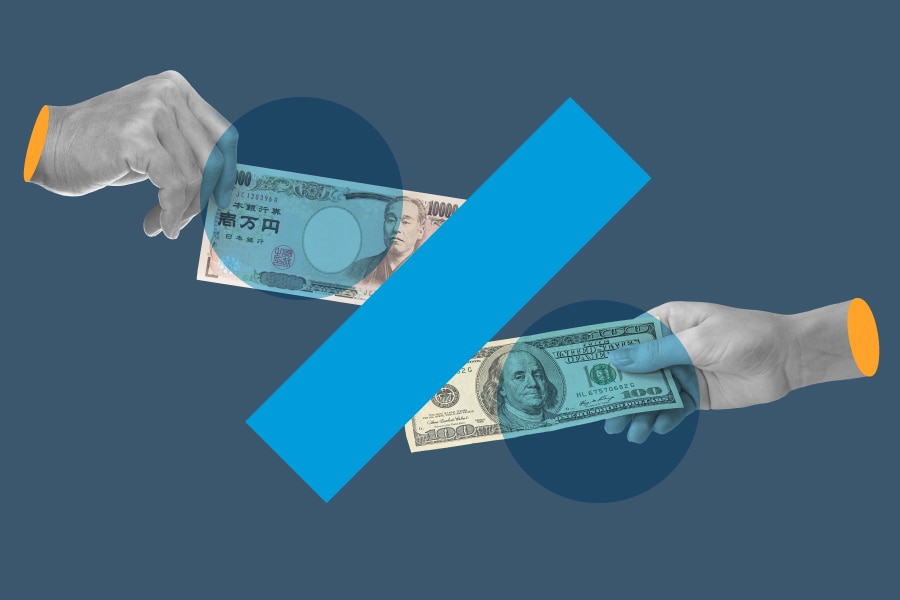"Yen-Carry" Anniversary Nears, but Worries Fade

Markets have muscle memory, so summer's approach might trigger unpleasant reminders of last year's post-July 4 Wall Street fireworks. The "yen-carry" crisis, as it became known, happened when the Bank of Japan (BoJ) raised interest rates more than expected last July 31, which, combined with other factors, caused a spike in the Japanese yen and a dramatic sell-off in the U.S. tech sector.
Muscle memory can linger, but in this case, it's likely to be unwarranted. Japanese yields are up, but a similar Japan-related dive in U.S. stocks is unlikely this summer. A record investor-long position in the yen is one of many reasons—the yen is up about 11% versus the U.S. dollar since last July's lows.
"The Japanese bond market could create volatility as higher yields attract domestic investors to repatriate money back to Japan and the BoJ reduces its balance sheet," said Michelle Gibley, director of international research at the Schwab Center for Financial Research. "However, we don't expect a repeat of the global market volatility seen last August because the shifts could be more gradual rather than all of a sudden."
Investors have embraced the yen partly because the BoJ raised its benchmark interest rate from below zero early last year to the current 0.5%—the highest since 2008—amid elevated inflation. Economists expect further rate hikes to come, with possible clarity on timing at the next BoJ meeting June 16–17. A more hawkish central bank generally strengthens a country's currency.
Another source of yen strength is uncertainty around U.S. tariff policy, which has hurt U.S. assets like the dollar and helped non-U.S. assets.
A year ago, things were very different. The July 31 BoJ rate hike occurred when a record number of speculator contracts were positioned to short the yen. The yen's sudden strength—which also reflected a weak U.S. jobs report and hawkish guidance by the BoJ—threatened to capsize the "yen carry trade," a move where investors borrow cheap yen to buy U.S. assets, particularly info tech stocks.
"Going long on tech and short on the yen were two very popular trades, because for many years, the yen had been the cheapest major funding currency and tech was consistently profitable," Gibley noted.
The Nasdaq-100® Index (NDX) fell 13% in less than a month as investors piled into the yen following the rate hike, sending it up 14% versus the dollar. The quick and related decline in the value of these assets purchased with yen-denominated borrowing forced some investors to unwind their trades by covering their shorts.
Those conditions don't exist today.
"Now, speculators are positioned very long yen," Gibley said. "Additionally, the spikes higher in longer-term Japanese government bond (JGB) yields are more due to low liquidity, little volume in those markets, as well as the BoJ reducing its holdings of bonds." That's also called "quantitative tightening," or QT, which is designed to slow inflation by raising yields.
Even if the BoJ raises rates by more than expected at coming meetings, investors are positioned for such moves in the currency, or forex, market and wouldn't necessarily be forced to exit positions elsewhere to adjust.
"While there is some risk of volatility when positioning is at an extreme, the potential impact would be less likely to be forced selling of assets that would lead to downward pressure on markets, given that investors are long rather than short," Gibley said.
If bond market volatility grows and threatens financial stability, the BoJ has choices. It could reduce QT and even buy bonds again if needed. That might require more volatility than seen so far, because the BoJ likely doesn't want to be seen as monetizing fiscal spending and doesn't want to abandon its rate-tightening cycle.
Recently, Japan's Ministry of Finance (MoF) said it was considering cutting issuance to improve the balance of supply and demand for JGBs. These remarks were enough to calm the markets.
"The BoJ and MoF may be able to continue to jawbone markets without actually needing to take decisive action," Gibley said.
The yen strength doesn't mean all is necessarily smooth. Japanese yields climbed again recently as investors clamored for higher rates in a 40-year bond auction, and U.S. yields rose in sympathy. However, U.S. yields fell in late May when Japan said it might cut bond issuance.
Still, with Japanese rates up along with U.S. trade uncertainty, there's a chance of investors embracing Japanese debt and selling U.S. Treasuries or foreign stocks. Japanese investors, especially banks, pensions, and insurance companies, hold lots of assets outside of Japan.
"With yields on JGBs rising and becoming more attractive, these institutions may repatriate money back home, but they are likely to do so gradually, not in snap, forced overnight decisions," Gibley said.
That could potentially send U.S. yields higher, raising borrowing costs and potentially slowing business and consumer spending. Which, in turn, might have an impact on U.S. stocks, but likely not so dramatically. And U.S. investors would have less reason to blame the yen.